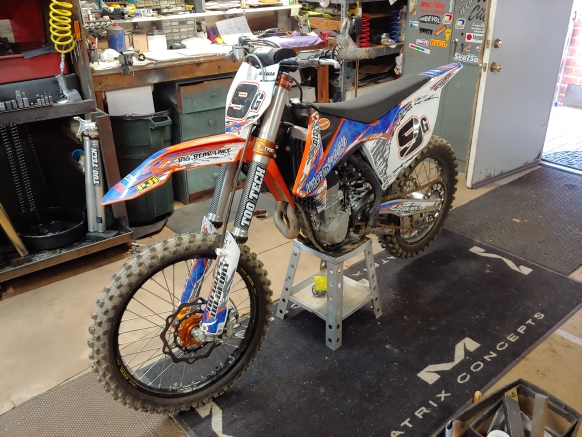2015-16 KTM Husky 4CS & Earlier Models

Successful Set-Up for MX by Too Tech. Currently in for service.
4CS Fork
The 4CS fork is very harsh as delivered. The small pistons and rods reduce the overall oil volume in the damping system. One must valve this system very carefully to achieve good metering with so little oil volume - but it can be done! The compression adjuster concept is completely different than any fork before and completely misunderstood by many suspension shops. I have seen companies converting the fork to an open chamber, changing the Mid Speed and Lo Speed pistons, changing the action of the adjuster knobs, and adding adjusters to the bottom fork bolts.
From our experience none of these changes or expense is required, and in most cases the performance is less.
Suspension companies were all used to having an adjustable orifice in parallel with the Low Speed valve stack. So this is all we knew and most assumed this was the best. So along comes the 4CS forks with the compression adjustment orifice in parallel with the Mid Speed valve stack. Many companies assumed this could not work and invented expensive and unnecessary additions. But after learning how to work with this new adjuster concept, we have come to like it allot, and feel it offers distinct advantages over the 'normal' Low Speed adjusters used by KTM and Showa. The majority of the oil crosses the Mid Speed stack so adjusting compression at this stack makes good technical sense! (BTW - the Hi & Lo speed adjustments on the new Honda fork do not adjust flow across the Mid Speed valve circuit so they are High Speed adjustments in name only....)
Bottom line is these forks can be made to work great for no more $ than any other fork we work on!
Shock
There is nothing wrong with the KTM / Husky White Power shock that valving cant fix. It doesn't need a new piston, just a valving strategy that works with large orifices. (Yamaha and some Honda use large orifice pistons and you don't see everyone changing those pistons) Although it uses smaller I. D. valve shims, it doesn't affect performance. Valving as delivered tends to hold the rear too high putting excess loads onto the overly stiff front end. The result is an overall stiff and harsh ride.
Overall
Most riders really like the handling of the new SX bikes. Our proprietary, but simple, valving upgrades make this bike a great choice for riders looking for something besides Japanese bikes.
2011 KTM 450 SX WITH NEW REAR SUSPENSION LINKAGE
The long awaited linkage style suspension with a new rear shock is finally here. My first impressions were great. I liked the bike size, and relationship of the bars, seat, and pegs. The bike seemed to sit a bit high but I hit the track with an open mind. Within 2 laps I decided the chassis and steering angles suited me really well (realize that my personal race bike is a CRF).
As great as the ergonomics were, I soon realized that the bike was far too harsh for the Milestone track's sharp edges and the bike rode too high in the turns. Riding too high raises the center of gravity and does not instill the confidence required to lean over far enough in the ruts. The forks were deflecting off the chop coming into the turns. This made it hard to set up well for the ruts.
A review of the spring rates exposed most of why the bike doesn't settle in the turns. The KTM 450 is using .50 front and a 5.8 kg/mm in the rear. (I rate them at .505 and 5.9 kg/mm). For comparison, most Japanese 450's come with about .47 front and 5.5 kg/mm rear. (These rates will be good for a 200 to 220 pound rider, but not my 170 pound frame.)
Since the bikes owner is 185 pounds, we went with .48 front and 5.6 kg/mm rear. After the springs were installed the bike settled better, but the harshness front and back was about the same. Back at the shop I revalved the forks using the same strategies as the other KTM bladder forks and then took a look at the new shock. The shock uses piston openings and valve sizes on par with Showa and KYB so applying existing valving strategies produced good results the first trip out. The biggest obstacle to good performance is the compression adjuster design.
After the first test ride on the new valving was complete, a huge improvement was noted by the owner. But being the perfectionist, we revalved everything again making addition changes to the fork mid-speed strategy for more bottoming control. We also revisited the compression adjuster again making it even more progressive. The second time out the owner was ecstatic as the bike sucked up more of the chop without bottoming. It also sinks further into the ruts for a lower center of gravity and more confidence. I called him a month later after he had ridden most of the tracks in So Cal and he still loved the bike and did not want any changes "period".
I was also really happy with the suspension and liked the bike overall.
Give us a chance to transform your KTM


